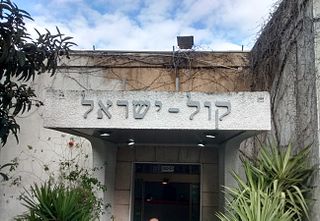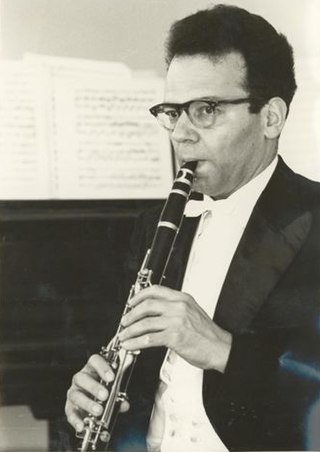The Israeli Declaration of Independence, formally the Declaration of the Establishment of the State of Israel, was proclaimed on 14 May 1948 by David Ben-Gurion, the Executive Head of the World Zionist Organization, Chairman of the Jewish Agency for Palestine, and soon to be first Prime Minister of Israel. It declared the establishment of a Jewish state in Eretz-Israel, to be known as the State of Israel, which would come into effect on termination of the British Mandate at midnight that day. The event is celebrated annually in Israel as Independence Day, a national holiday on 5 Iyar of every year according to the Hebrew calendar.

The Israel Philharmonic Orchestra is a major Israeli symphony orchestra based in Tel Aviv. Its principal concert venue is Heichal HaTarbut.

Independence Hall, originally the Dizengoff House is the site of the signing of Israel's Declaration of Independence. It is located on the historic Rothschild Boulevard in Tel Aviv, Israel. From 1932 to 1971 housing the Tel Aviv Museum of Art, it is currently a museum dedicated to the signing of the Israeli Declaration of Independence and the history of Tel Aviv.

Kol Yisrael or Kol Israel was Israel's public domestic and international radio service. It operated as a division of the Israel Broadcasting Service from 1951 to 1965, the Israel Broadcasting Authority from 1965 to 2017, and the radio stations it used to administer are currently administered by the Israeli Broadcasting Corporation.
Kol Tsion HaLokhemet was the underground radio station of the Irgun.
Pnina Salzman was an Israeli classical pianist and piano pedagogue.
The Shehecheyanuberakhah (blessing) is a common Jewish prayer to celebrate special occasions. It expresses gratitude to God for new and unusual experiences or possessions. The blessing was recorded in the Talmud over 1500 years ago.

Zvi Lurie was a Jewish political figure in Mandatory Palestine. A member of the Jewish National Council, he was amongst the signatories of the Israeli declaration of independence.
Kol HaAm was a Hebrew-language newspaper in Mandatory Palestine and Israel. It was initially published by the Palestine Communist Party and later by its successor, the Israeli Communist Party.

Yona Ettlinger was a clarinetist who played and taught in Israel, France and England. Ettlinger is considered a prominent classical clarinetist of his generation, and one of Israel's notable instrumentalists. His musicianship and unique sound influenced the art of clarinet playing in Israel and Europe in the second half of the 20th century. Many clarinet soloists and orchestra players of different countries were among his students.

Jerusalem Calling was the radio station established by the British Mandatory Authority through its broadcasting wing, the Palestine Broadcasting Service. It broadcast in three languages, Arabic, English and Hebrew.

Daniel Pe'er was an Israeli television host and newsreader.

The Levant Fair was an international trade fair held in Tel Aviv during the 1920s and 1930s.

The following is an alphabetical list of articles related to Israel.

Astrith Baltsan is an Israeli concert pianist and musicologist.

Mordechai Rechtman was an Israeli bassoonist, conductor, academic teacher and arranger. He was principal bassoonist of the Israel Philharmonic Orchestra from 1946 to 1991. He was professor of bassoon at the Tel Aviv University from 1968 to 2002, and taught as a guest professor internationally, including the Indiana University School of Music, the Juilliard School and the Royal Academy of Music. Rechtmann was also known for transcriptions and arrangements for wind quintets and other ensembles that he had founded and conducted, specifically of concertos.

Shimon Rudolf "Rudi" Weissenstein was an Israeli photographer. He was best known for his extensive photo documentation of the everyday life of Jewish immigrants in the 1930s. The only photographs of Israel's declaration of independence by David Ben Gurion in 1948 are by Weissenstein, who built a collection of over a million negatives.

Bracha Zefira was a pioneering Israeli folk singer, songwriter, musicologist, and actress of Yemenite Jewish origin. She is credited with bringing Yemenite and other Middle Eastern Jewish music into the mix of ethnic music in Palestine to create a new "Israeli style", and opening the way for other Yemenite singers to succeed on the Israeli music scene. Her repertoire, which she estimated at more than 400 songs, included Yemenite, Bukharan, Persian, Ladino, and North African Jewish folk songs, and Arabic and Bedouin folk songs and melodies.

Shmuel Cohen (1870–1940) composed the music for the Israeli national anthem, the "Hatikvah" - "The Hope".
Am Yisrael Chai is a Jewish solidarity anthem and a widely used expression of Jewish peoplehood and an affirmation of the continuity of the Jewish people. The phrase gained popularity during the Student Struggle for Soviet Jewry, when Jewish songwriter Shlomo Carlebach composed the song for the movement's 1965 solidarity rally in New York City.
















